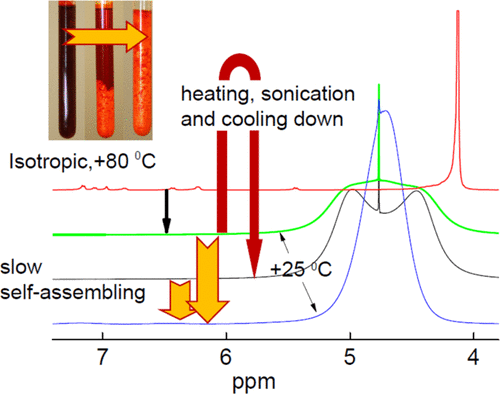当前位置:
X-MOL 学术
›
J. Phys. Chem. B
›
论文详情
Our official English website, www.x-mol.net, welcomes your
feedback! (Note: you will need to create a separate account there.)
NMR, Raman, and DFT Study of Lyotropic Chromonic Liquid Crystals of Biomedical Interest: Tautomeric Equilibrium and Slow Self-Assembling in Sunset Yellow Aqueous Solutions
The Journal of Physical Chemistry B ( IF 2.8 ) Pub Date : 2018-02-28 00:00:00 , DOI: 10.1021/acs.jpcb.8b00350 Kristina Kristinaitytė 1 , Aru̅nas Maršalka 1 , Laurynas Dagys 1 , Kęstutis Aidas 1 , Iryna Doroshenko 2 , Yevhenii Vaskivskyi 2 , Yelyzaveta Chernolevska 2 , Valeriy Pogorelov 2 , Nomeda Rima Valevičienė 3 , Vytautas Balevicius 1
The Journal of Physical Chemistry B ( IF 2.8 ) Pub Date : 2018-02-28 00:00:00 , DOI: 10.1021/acs.jpcb.8b00350 Kristina Kristinaitytė 1 , Aru̅nas Maršalka 1 , Laurynas Dagys 1 , Kęstutis Aidas 1 , Iryna Doroshenko 2 , Yevhenii Vaskivskyi 2 , Yelyzaveta Chernolevska 2 , Valeriy Pogorelov 2 , Nomeda Rima Valevičienė 3 , Vytautas Balevicius 1
Affiliation

|
Temperature and composition effects in Sunset Yellow FCF (SSY) aqueous solutions were studied by the 1H, 15N NMR as well as Raman spectroscopy passing through all phase transitions between isotropic phase (I) and chromonic phases—nematic (N) and columnar (M). It was shown that the tautomeric equilibrium in SSY is strongly shifted toward the hydrazone form. The corresponding equilibrium constant pKT = 2.5 was deduced using the density functional theory solvent model density model. The dominance of the hydrazone form was confirmed experimentally using the long-range 1H–15N correlation, widely known as heteronuclear multiple bond correlation. The peak found in the 1H NMR spectra at ca. 14.5 ppm can be attributed to the proton in the intramolecular N–H···O bond. The existence of this signal shows that (i) the growth of the SSY aggregates is accompanied by the segregation of water in the intercolumnar areas with no access for exchange with the N–H protons in the internal layers of the columnar stacks and that (ii) the lifetime of those aggregates is ≥10–8 s or even longer. The temperature dependences of H2O chemical shift and Raman O–H stretching band shape show that water confined in the intercolumnar areas behaves as in the neat substance. When the sample is heated and the transition from M phase to N phase occurs, the molecular motion of water is seen to change in a manner similar to that when water is melting. The equilibration time for N + M→ M is very long because of slow supramolecular restructuring, i.e., the growing of columnar stacks and building of hexagonal arrays. If the sample is cooled down to the temperature below N → M transition relatively fast, the structural changes are behind, and the system falls into supercooled state. In this case, the system evolves via long-lasting self-assembling from the supercooled state to the equilibrium. This process affects the shape of the 1H NMR signal and is easy to monitor.
中文翻译:

核磁共振,拉曼和DFT研究的生物医学感兴趣的溶致色团液晶:互变异构平衡和日落黄色水溶液中缓慢的自组装。
通过1 H,15 N NMR和拉曼光谱研究了各向同性相(I)和发色相(向列相(N)和柱状( M)。结果表明,SSY中的互变异构平衡强烈地向toward形式转移。使用密度泛函理论溶剂模型密度模型推导相应的平衡常数p K T = 2.5。using形式的优势已通过使用长距离1 H– 15 N相关性实验确定,该相关性被广泛称为异核多键相关性。在1中发现的峰值1H NMR谱图。14.5 ppm可以归因于分子内N–H···O键中的质子。该信号的存在表明(i)SSY聚集体的生长伴随着水在柱间区域的分离,无法与柱状烟囱内层的N–H质子交换,并且(ii )那些聚集体的寿命是≥10 -8秒或甚至更长。H 2的温度依赖性O的化学位移和拉曼OH拉伸带的形状表明,限制在柱间区域的水的行为与纯净物质的行为相同。当样品被加热并且发生从M相到N相的转变时,可以看到水的分子运动以与水熔化时相似的方式改变。N + M→M的平衡时间很长,因为超分子重组缓慢,即柱状堆叠体的生长和六边形阵列的建立。如果将样品冷却到N→M转变以下的温度相对较快,则结构变化会滞后,系统会进入过冷状态。在这种情况下,系统通过持久的自组装从过冷状态演化到平衡状态。这个过程会影响1的形状1 H NMR信号且易于监测。
更新日期:2018-02-28
中文翻译:

核磁共振,拉曼和DFT研究的生物医学感兴趣的溶致色团液晶:互变异构平衡和日落黄色水溶液中缓慢的自组装。
通过1 H,15 N NMR和拉曼光谱研究了各向同性相(I)和发色相(向列相(N)和柱状( M)。结果表明,SSY中的互变异构平衡强烈地向toward形式转移。使用密度泛函理论溶剂模型密度模型推导相应的平衡常数p K T = 2.5。using形式的优势已通过使用长距离1 H– 15 N相关性实验确定,该相关性被广泛称为异核多键相关性。在1中发现的峰值1H NMR谱图。14.5 ppm可以归因于分子内N–H···O键中的质子。该信号的存在表明(i)SSY聚集体的生长伴随着水在柱间区域的分离,无法与柱状烟囱内层的N–H质子交换,并且(ii )那些聚集体的寿命是≥10 -8秒或甚至更长。H 2的温度依赖性O的化学位移和拉曼OH拉伸带的形状表明,限制在柱间区域的水的行为与纯净物质的行为相同。当样品被加热并且发生从M相到N相的转变时,可以看到水的分子运动以与水熔化时相似的方式改变。N + M→M的平衡时间很长,因为超分子重组缓慢,即柱状堆叠体的生长和六边形阵列的建立。如果将样品冷却到N→M转变以下的温度相对较快,则结构变化会滞后,系统会进入过冷状态。在这种情况下,系统通过持久的自组装从过冷状态演化到平衡状态。这个过程会影响1的形状1 H NMR信号且易于监测。











































 京公网安备 11010802027423号
京公网安备 11010802027423号